News and Announcements

- November 23, 2025

Our article Redundancy in WiFi 7: Combining Multi-link Operation with IEEE 802.1CB FRER has been accepted for publication in Elsevier Computer Communications.
The increasing complexity of modern industrial and manufacturing systems, featuring numerous sensors and mobile components, demands reliable, low-latency communication over wireless networks. WiFi 7 addresses these requirements through enhancements such as Multi-Link Operation (MLO), enabling simultaneous use of multiple frequency bands and offering inherent link diversity. This raises the question of whether MLO can be effectively leveraged for reliability in critical systems. In this paper, we explore the integration of IEEE 802.1CB Frame Replication and Elimination for Reliability (FRER), a core Time-Sensitive Networking (TSN) standard, over MLO to address this question. We present an open-source implementation of FRER over MLO in the OMNeT++ simulator, highlight key challenges in combining these technologies, and evaluate its effectiveness in improving reliability under wireless-specific conditions such as mobility and congestion. Our results demonstrate that FRER can enhance packet delivery ratio and ensure bounded latency, albeit at the expense of reduced channel efficiency due to redundancy.
(link to more information)
- November 20, 2025
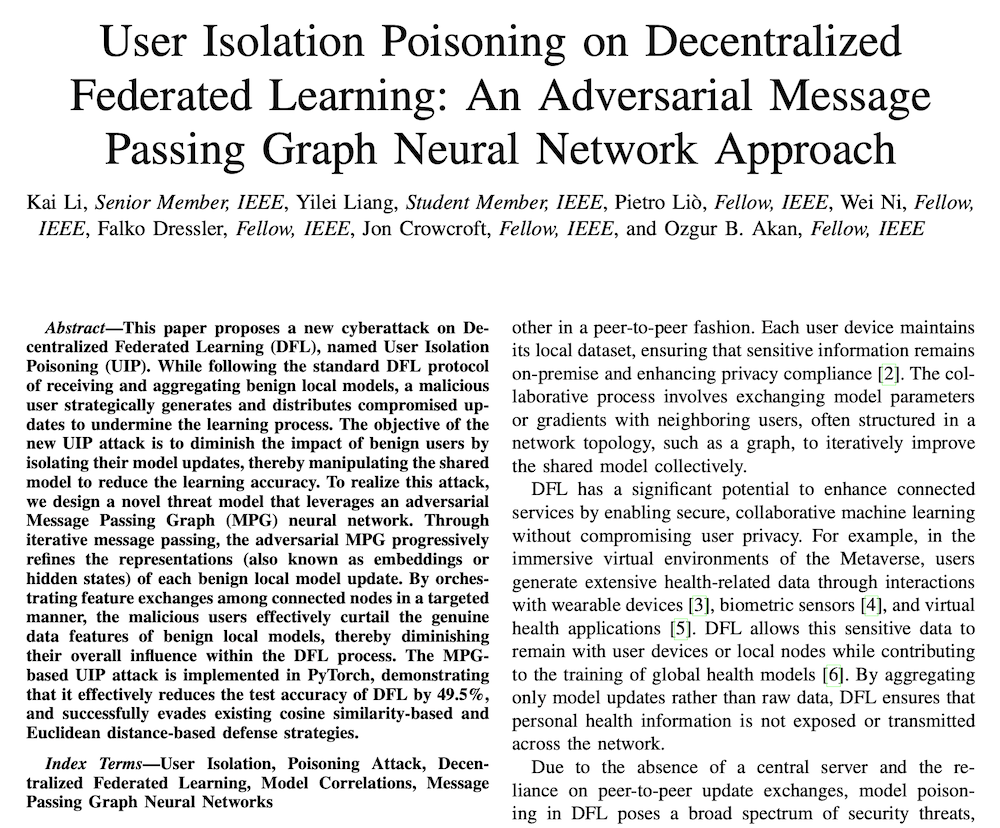
Our article User Isolation Poisoning on Decentralized Federated Learning: An Adversarial Message Passing Graph Neural Network Approach has been accepted for publication in the IEEE Transactions on Neural Networks and Learning Systems.
(link to more information)
- November 07, 2025

TKN group presented three research contributions at the 31st ACM International Conference on Mobile Computing and Networking (MobiCom 2025), which was held in Hong Kong, China.
Joana Angjo and Elena Tonini presented our poster mmWave CSI-based Sensing: a Feasibility Study
and
Doğanalp Ergenç presented our poster Towards Open Wireless Time-sensitive Networking in Linux.
Furthermore, Youming Tao presented the our paper Differentially Private Matroid Bandits for Online Network Topology Optimization at the associated MobiArch workshop.
- November 06, 2025
We are looking for talented students who want to pursue their PhD studies at the School of Electrical Engineering and Computer Science, TU Berlin, Germany. The positions are part of the Telecommunication Networks group headed by Prof. Falko Dressler.
Mission-critical systems, such as in industrial automation, rely on highly resilient, low-latency communication networks. However, current networking solutions - such as time-sensitive networking (TSN) for wired communication and WiFi 7 or 5G for wireless - lack a unified, resilience-centric approach that can withstand impaired link conditions, failures, and cyber-attacks. Accordingly, The Resilient Hybrid Time-sensitive Networks (RESERVE) project aims to ensure reliable end-to-end QoS through seamless hybrid integration that supports real-time, mixed-criticality traffic across wired and wireless links. Hybrid networks will be designed to adapt dynamically to failures, interference, and mobility without compromising service reliability. To enable scalable and adaptive orchestration, centralized, decentralized, and distributed control models will be investigated for resilient reconfiguration. In RESERVE, these objectives will be pursued through analytical modeling, AI-driven optimization, large-scale simulations, and real-world testbeds, leveraging TSN, WiFi 7, and 5G/6G technologies.
(link to more information)
- November 04, 2025
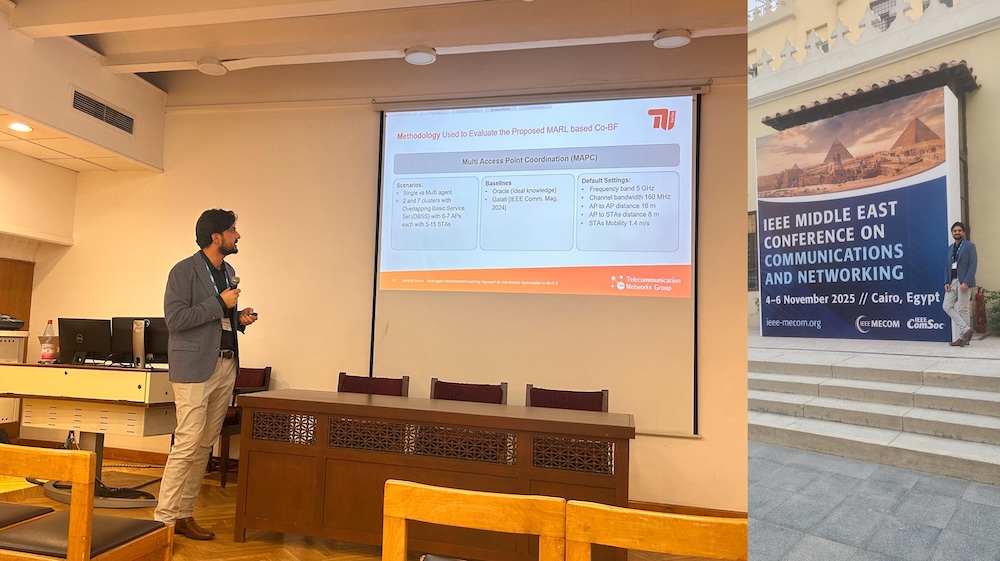
Our team member Jamshid Bacha recently had the opportunity to present our paper Multi-Agent Reinforcement Learning Approach for Interference Optimization in Wi-Fi 8 at the Middle East Conference on Communications and Networking (MECOM 2025) at the University of America in Cairo, Egypt.
This work addresses a key challenge in modern wireless networks: interference management in dense Wi-Fi 8 deployments. We propose a multi-agent reinforcement learning (MARL) framework that allows nearby access points (APs) to coordinate their beamforming and nulling decisions. The approach combines dynamic clustering to reduce channel state information overhead with intelligent coordination to improve spatial reuse.
- October 28, 2025
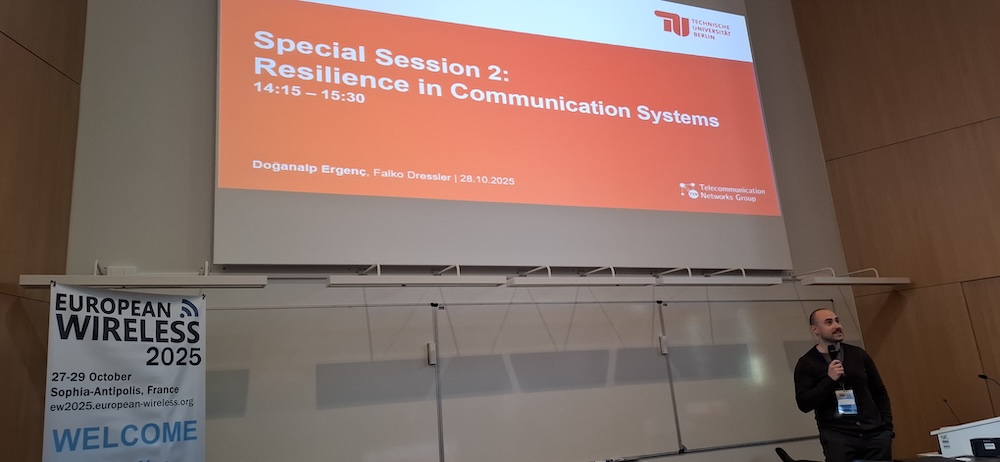
Dr. Doganalp Ergenc and Prof. Falko Dressler chaired a special session on Resilience in Communication Systems at EW 2025, France. There were six papers presented in the session, addressing different resilience challenges and featuring authors from the Resilient Worlds team. You can access the full list of paper at the EW website.
- October 25, 2025
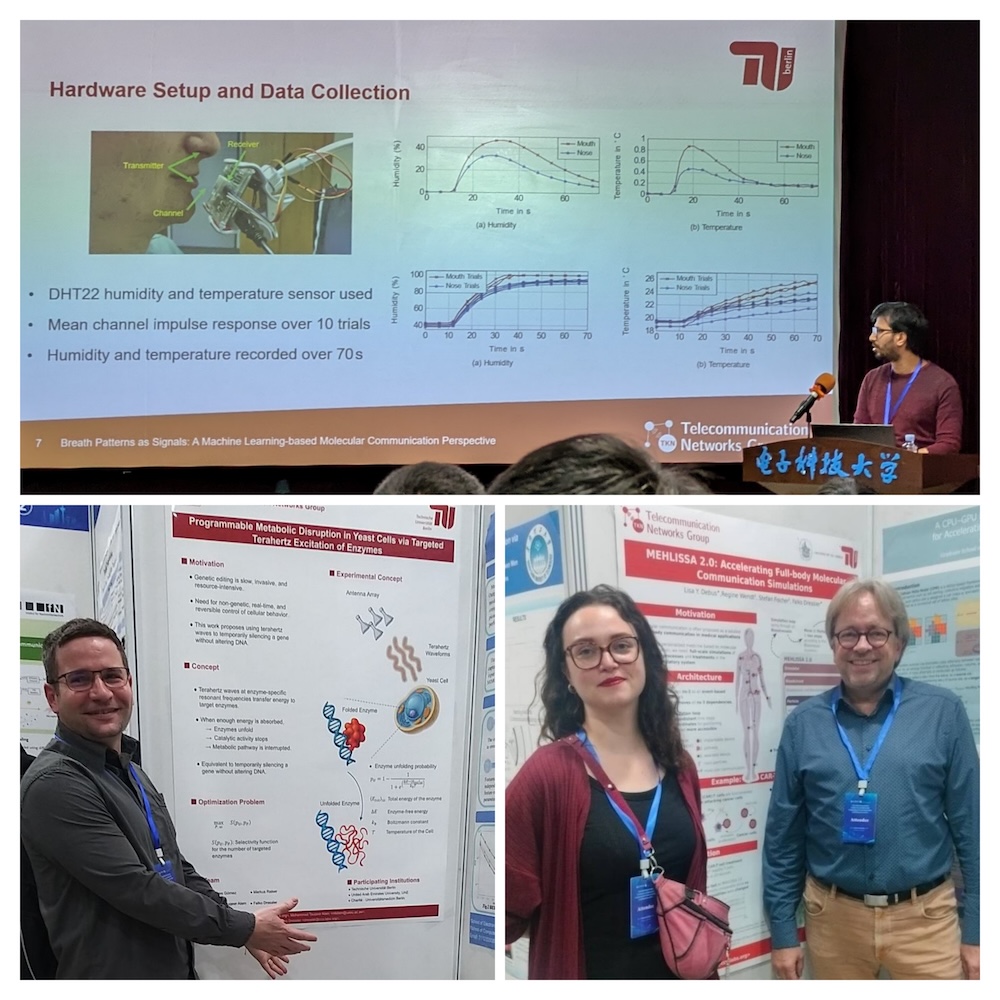
The TKN group presented three research contributions at the 12th ACM International Conference on Nanoscale Computing and Communication (NanoCom 2025) in Chengdu, China.
Sunasheer Bhattacharjee presented his work on the detection of breath abnormalities using molecular communication in Breath Patterns as Signals: A Machine Learning-based Molecular Communication Perspective.
Jorge Torres Gómez presented our poster Programmable Metabolic Disruption in Yeast Cells via Targeted Terahertz Excitation of Enzymes
and
Lisa Y. Debus presented the new version of our full-body simulation tool in collaboration with the University of Lübeck MEHLISSA in our poster MEHLISSA 2.0: Accelerating Full-body Molecular Communication Simulations.
- October 16, 2025
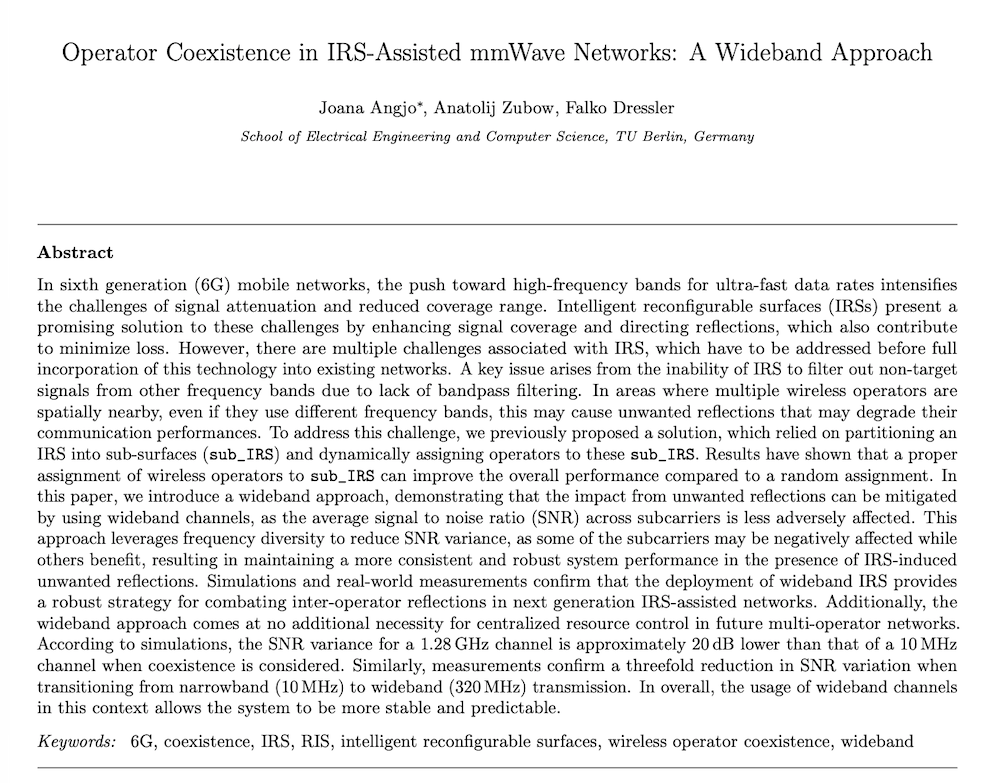
Our article Operator Coexistence in IRS-Assisted mmWave Networks: A Wideband Approach has been accepted for publication in Elsevier Computer Communications.
Intelligent reconfigurable surfaces (IRSs) present a promising solution to these challenges by enhancing signal coverage and directing reflections, which also contribute to minimize loss. However, there are multiple challenges associated with IRS, which have to be addressed before full incorporation of this technology into existing networks. A key issue arises from the inability of IRS to filter out non-target signals from other frequency bands due to lack of bandpass filtering. In areas where multiple wireless operators are spatially nearby, even if they use different frequency bands, this may cause unwanted reflections that may degrade their communication performances. To address this challenge, we previously proposed a solution, which relied on partitioning an IRS into sub-surfaces (sub_IRS) and dynamically assigning operators to these sub_IRS. Results have shown that a proper assignment of wireless operators to sub_IRS can improve the overall performance compared to a random assignment. In this paper, we introduce a wideband approach, demonstrating that the impact from unwanted reflections can be mitigated by using wideband channels, as the average signal to noise ratio (SNR) across subcarriers is less adversely affected. This approach leverages frequency diversity to reduce SNR variance, as some of the subcarriers may be negatively affected while others benefit, resulting in maintaining a more consistent and robust system performance in the presence of IRS-induced unwanted reflections.
(link to more information)
- October 15, 2025
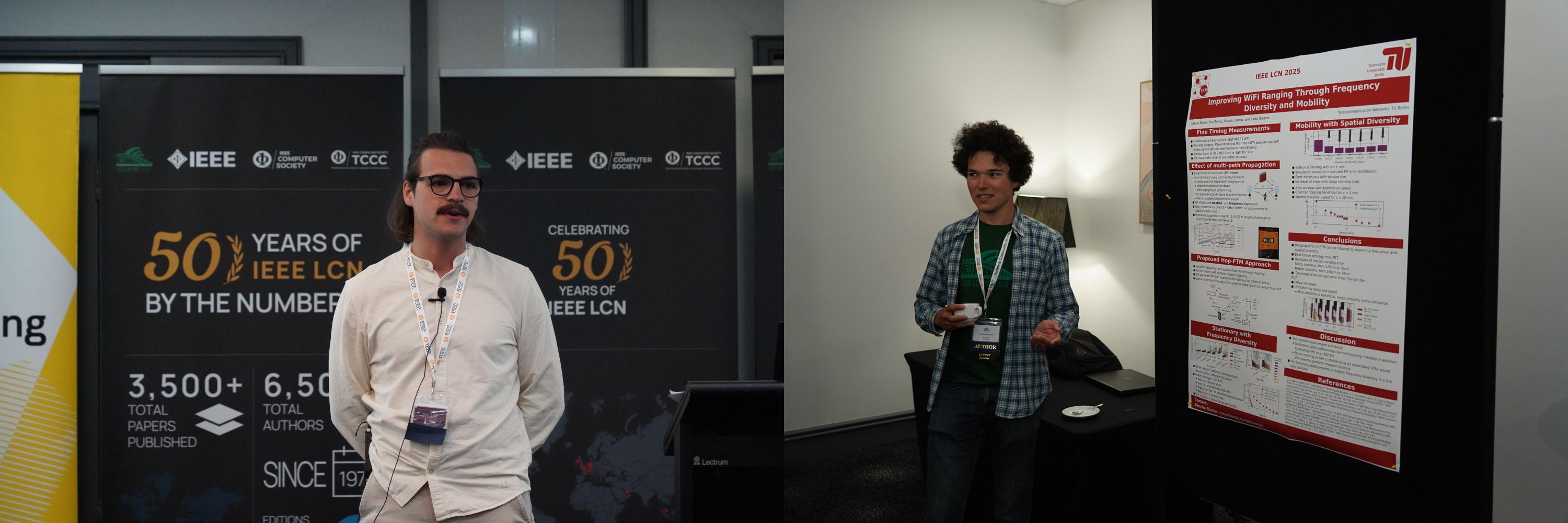
Simon Schmitz-Heinen and Sascha Rösler presented our paper Ce-Fi: Centralized Wi-Fi over Packet-Fronthaul and our poster Improving WiFi Ranging Through Frequency Diversity and Mobility at the Conference on Local Computer Networks (LCN), Sydney, Australia.
The first work investigates Ce-Fi, a centralized Wi-Fi architecture operating over a packet-based fronthaul (FH) connecting the central unit with the remote radio heads. Ce-Fi employs a two-level design with two bands: the network discovery and user association is handled standard compliantly on one band while another band is used for the actual data transmission with the centralized Wi-Fi. To tolerate the FH-induced delay, we propose minor changes to the 802.11 medium access control protocol like NAV extension and the usage of a piggybacking mechanism enabling the C-RAN-AP to transmit without prior channel contention.
The poster presents HopFTM to enhance FTM ranging accuracy by leveraging frequency diversity and space diversity through mobility. Specifically, HopFTM performs ranging on multiple radio channels. Additionally, in a mobile scenario, ranging is performed at multiple locations. Our experimental results using low-cost ESP32-S3 hardware reveal that selecting the smallest RTT value from all measured channels significantly improves accuracy, especially in environments with strong multi-path effects or non-line-of-sight conditions. In a static scenario by using the smallest RTT from four channels, we were able to reduce the median ranging error by 4× from 120 cm to 30 cm while the worst-case error was decreased from 15 m to 10 m, compared to traditional single-channel approach. In a mobile scenario, ranging measurements taken at different locations outside the decorrelation distance can also be fused. Our simulation shows that taking the smallest RTT value over multiple positions can improve FTM ranging error from 1.8 m to 0.76 m.
- October 13, 2025
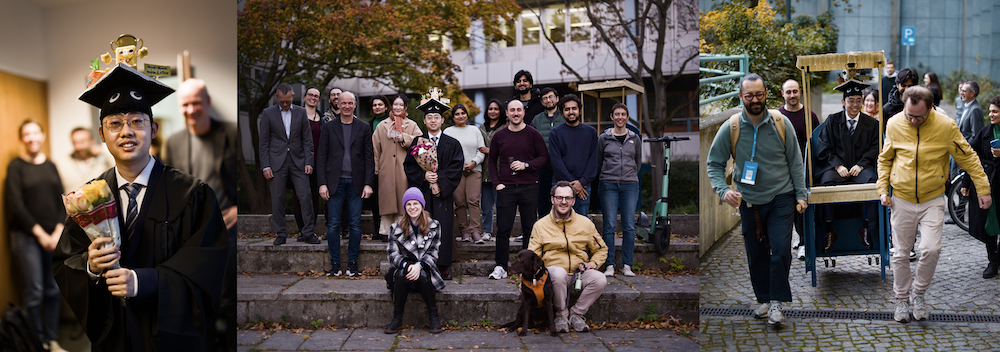
Youming Tao successfully defended his PhD on October 13, 2025.
His dissertation is titled "Trustworthy Collaborative Machine Learning for Edge AI: Privacy, Unlearning, and Robustness".
He was awarded a Dr.-Ing. degree (with distinction) from TU Berlin.
(link to more information)













